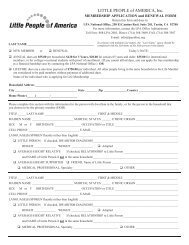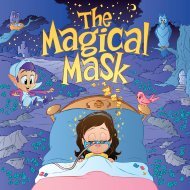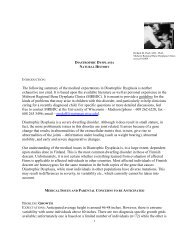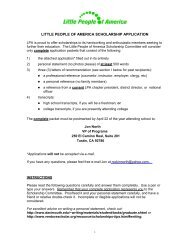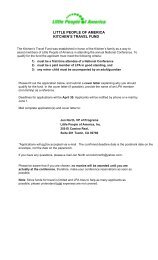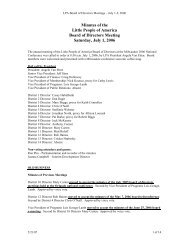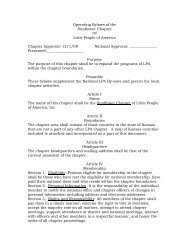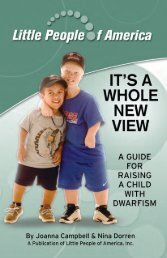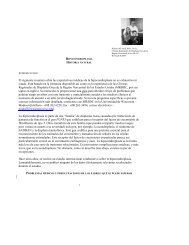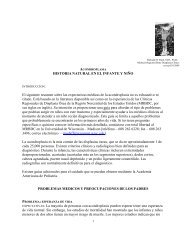Pseudoachondroplasia - Little People of America, Inc.
Pseudoachondroplasia - Little People of America, Inc.
Pseudoachondroplasia - Little People of America, Inc.
- No tags were found...
You also want an ePaper? Increase the reach of your titles
YUMPU automatically turns print PDFs into web optimized ePapers that Google loves.
PROBLEM: DEVELOPMENTEXPECTATIONS: Intelligence is normal. Variations in developmental patterns are to be expectedbecause <strong>of</strong> short stature and joint instability.MONITORING: Routine.INTERVENTION: None.PROBLEM: LEG POSITIONAL ABNORMALITIESEXPECTATIONS: Beginning after orthograde weightbearing, nearly all develop some knee and legposition abnormality. By far the most common is varus deformity (bowleg) although somedevelop either bilateral knee valgus or a windsweep (valgus on one side and varus on the other).Progressive deformity, in conjunction with laxity and instability <strong>of</strong> the knees, results in activityassociated pain.MONITORING: Clinical monitoring for alignment, development <strong>of</strong> chronic knee pain, limitation <strong>of</strong>ambulation (usually secondary to pain).INTERVENTION: Surgery should be delayed as long as possible since, if correction is done early,then repeated surgery is quite likely. Recurrence presumably arises because <strong>of</strong> persistentasymmetric growth at the growth plate. Often multilevel osteotomies are needed (i.e. correctionat both the distal femoral and proximal tibial levels). Osteotomies require meticulous alignmentand should be done by a pediatric orthopedist experienced in performing such surgery onindividuals with pseudoachondroplasia.PROBLEM: THORACOLUMBOSACRAL SPINEEXPECTATIONS: There is high risk for kyphoscoliosis, usually beginning in late childhood oradolescence, eventually affecting at least 50% <strong>of</strong> individuals. Hyperlordosis <strong>of</strong> the lumbosacralregion is common.MONITORING: Clinical examination every 6 months. AP and lateral spine x-rays if any clinicalindication <strong>of</strong> a kyphoscoliotic curve developing.INTERVENTION: Kyphoscoliosis <strong>of</strong>ten will require bracing in childhood but only relativelyinfrequently will require surgical fusion. Hyperlordosis is far less <strong>of</strong> a concern, but if it results inlow back symptoms, then an exercise program for strengthening <strong>of</strong> lower abdominal muscles and'tucking under' may be helpful.PROBLEM: CERVICAL SPINEEXPECTATIONS: Although the risk may not be as great as in other forms <strong>of</strong> spondyloepiphysealdysplasia, odontoid hypoplasia and/or cervical spine instability is present in a minority [perhapsabout one in six]. Instability is more <strong>of</strong>ten seen in those with odontoid hypoplasia/osodontoideum. If present there is considerable risk for upper cervical cord compression[chronically or acutely].MONITORING: Lateral cervical spine films [flexion, neutral and extension] should be obtainedwhen the diagnosis <strong>of</strong> pseudoachondroplasia is first made; if abnormal or equivocal, repeat aspart <strong>of</strong> complete assessment every 6 months. In those with possible neurologic abnormality,multiposition magnetic resonance imaging may help determine if surgical intervention is needed.2
INTERVENTION: Treatment for severe, symptomatic instability is cervical fusion, which, however,is rarely needed.PROBLEM: HIPSEXPECTATIONS: Hip degeneration and premature osteoarthritis is nearly uniform and more thanhalf will have total hip replacement, <strong>of</strong>ten in the 30s or 40s. Although requiring customprostheses, such hip replacement can be successfully completed.MONITORING: Radiologic assessment with symptoms.INTERVENTION: Limitations <strong>of</strong> repetitive weight bearing activities and other activities that resultin repetitive stress on the hips, such as rope jumping, trampoline use etc., can slow degenerativearthritic changes; Use <strong>of</strong> a motorized scooter for long distance mobility is warranted beginning atearly school age.PROBLEM: OTHER LARGE JOINT SYMPTOMSEXPECTATIONS: Problems may include – ankle instability; shoulder subluxability; generalizedmorning stiffness.MONITORING: Clinical monitoring.INTERVENTION: AFOs may benefit if ankle instability is particularly severe. Morning stiffnessmay be relieved by use <strong>of</strong> an eggcrate mattress and morning baths or whirlpool.PROBLEM: WRIST AND INTRINSIC HAND JOINT INSTABILITYEXPECTATIONS: Pr<strong>of</strong>ound hypermobility <strong>of</strong> the wrists and the intrinsic joints, along with markedbrachydactyly, arise in childhood and may result in fatigue when doing fine motor functions suchas writing, drawing etc.MONITORING: Occupational therapy monitoring in school.INTERVENTION: Initiation <strong>of</strong> early keyboarding and substitution <strong>of</strong> keyboarding for manualwriting may be needed.PROBLEM: ADAPTIVEEXPECTATIONS: Considerable psychological and physical adaptive needs may arise later inchildhood.MONITORING: Assess for age appropriate needs.INTERVENTION: School adaptations, stools, teacher involvement, <strong>Little</strong> <strong>People</strong> <strong>of</strong> <strong>America</strong>involvement.GENETICS AND MOLECULAR BIOLOGY<strong>Pseudoachondroplasia</strong> appears always to be caused by an autosomal dominant gene abnormality.This means that an adult with this disorder will have a 50% chance to pass this poorly functionalgene on to each child. Not infrequently an individual with this disorder will be born to averagestatured parents. When this happens it usually is because <strong>of</strong> a new chance change (mutation) in3
only the single egg or single sperm giving rise to the affected individual. However, instances <strong>of</strong>germinal mosaicism are not rare (and, in fact, before this phenomenon was recognized this led tothe incorrect hypothesis that there was a recessive form <strong>of</strong> this disorder). Germinal mosaicism issufficiently common that a risk <strong>of</strong> about 1-2% for recurrence after the birth <strong>of</strong> one affected childto parents <strong>of</strong> average stature is probably a reasonable estimate. If two parents <strong>of</strong> average staturealready have more than one affected child, then recurrence risk is much greater and mayapproach 50%.All individuals with pseudoachondroplasia have mutations in a gene which codes for CartilageOligomeric Matrix Protein (COMP). Other mutations at this same locus sometimes cause aclinically related but milder disorder called Multiple Epiphyseal Dysplasia.4



